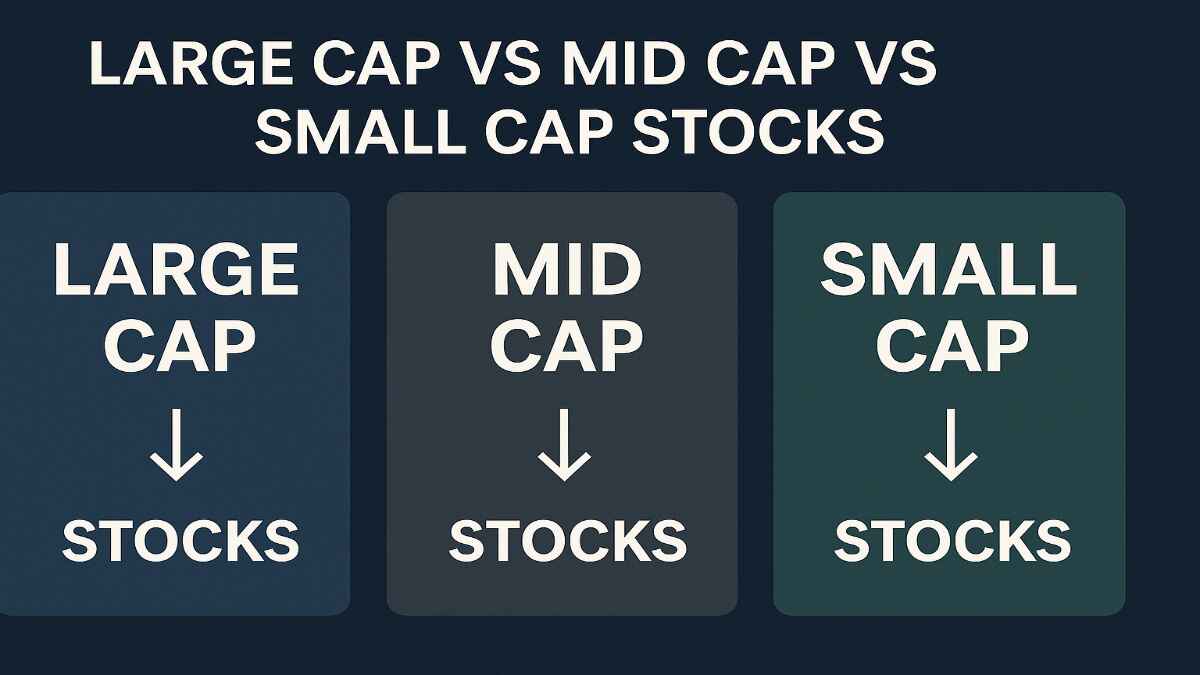Introduction
The stock market in India is a vibrant avenue for wealth creation, but it can be daunting for beginners. One key concept to grasp is market capitalization, which divides stocks into Large Cap, Mid Cap, and Small Cap categories. Understanding Large Cap vs Mid Cap vs Small Cap Stocks is crucial for making informed investment decisions.
These categories reflect a company’s size, risk, and growth potential, helping investors align their portfolios with their financial goals. In this guide, we’ll explore Large Cap vs Mid Cap vs Small Cap Stocks in the Indian context, covering their characteristics, advantages, disadvantages, and investment strategies. Whether you’re a conservative investor or a risk-taker, this article will equip you with the knowledge to navigate the market confidently.
Table of Contents
What is Market Capitalization?
Market capitalization, or market cap, measures a company’s total market value. It’s calculated by multiplying the current share price by the number of outstanding shares. For example, if a company has 10 million shares priced at Rs 100 each, its market cap is Rs 100 crore. In India, the Securities and Exchange Board of India (SEBI) and the Association of Mutual Funds in India (AMFI) use market cap to classify stocks:
- Large Cap: Top 100 companies by market cap, typically above Rs 20,000 crore.
- Mid Cap: Companies ranked 101-250, with market caps between Rs 5,000 and 20,000 crore.
- Small Cap: Companies ranked 251 and beyond, with market caps below Rs 5,000 crore.
Market cap is a vital indicator because it correlates with a company’s stability, liquidity, and growth potential. Understanding Large Cap vs Mid Cap vs Small Cap Stocks helps investors choose stocks that match their risk tolerance and investment horizon.
Large Cap Stocks
Definition and Criteria
Large Cap stocks belong to the top 100 companies in India by market capitalization, typically exceeding Rs 20,000 crore. These are well-established firms with a strong market presence, often household names. Examples include Reliance Industries, Tata Consultancy Services (TCS), and Hindustan Unilever.
Characteristics
- Stability: Large Caps have proven business models and are less affected by market fluctuations.
- Liquidity: High trading volumes make it easy to buy or sell shares.
- Lower Risk: Their size and reputation reduce investment risk compared to smaller companies.
- Dividend Payouts: Many Large Caps offer regular dividends, providing steady income.
Advantages
- Safety: Ideal for conservative investors seeking capital preservation.
- Liquidity: High trading volumes ensure quick transactions without price impact.
- Research Coverage: Extensive analyst coverage provides ample information.
- Diversification: Large Caps span various sectors, aiding portfolio balance.
Disadvantages
- Limited Growth: As mature companies, their growth rates are slower.
- High Valuations: Popular Large Caps may be overpriced, reducing returns.
- Less Agility: Slow to adapt to market changes or new technologies.
Historical Performance
Large Caps tend to perform steadily, especially during market downturns. According to Groww, their average 5-year returns are around 7%, reflecting their stability but lower growth potential compared to Large Cap vs Mid Cap vs Small Cap Stocks.
Mid Cap Stocks
Definition and Criteria
Mid Cap stocks are companies ranked 101-250 by market cap, with values between Rs 5,000 and 20,000 crore. These firms are in a growth phase, balancing stability and expansion. Examples include Metropolis Healthcare, Castrol India, and LIC Housing Finance.
Characteristics
- Growth Potential: Higher growth than Large Caps but more established than Small Caps.
- Moderate Risk: More volatile than Large Caps but less risky than Small Caps.
- Liquidity: Moderate trading volumes, less liquid than Large Caps.
- Innovation: Often expanding into new markets or products.
Advantages
- Balanced Risk and Reward: Suitable for investors seeking growth with moderate risk.
- Growth Opportunities: Potential to become Large Caps, offering significant returns.
- Undervalued Opportunities: Some Mid Caps may be underpriced, providing value.
Disadvantages
- Higher Volatility: More price fluctuations than Large Caps.
- Less Liquidity: Harder to trade large quantities without affecting prices.
- Limited Research: Less analyst coverage compared to Large Caps.
Transition to Large Caps
Many Mid Caps grow into Large Caps, delivering substantial returns. For example, companies like Bajaj Finance started as Mid Caps before becoming Large Caps. Understanding Large Cap vs Mid Cap vs Small Cap Stocks helps identify such opportunities.
Small Cap Stocks

Definition and Criteria
Small Cap stocks are companies ranked 251 and beyond by market cap, typically below Rs 5,000 crore. These are smaller firms in early growth stages, often operating in niche markets. Examples include Bajaj Consumer Care, Shobha Ltd, and VST Industries.
Characteristics
- High Growth Potential: Significant upside due to their early-stage status.
- High Risk: More volatile and susceptible to economic changes.
- Low Liquidity: Low trading volumes make trading challenging.
- Innovation: Often introduce innovative products or services.
Advantages
- High Returns: Potential for substantial capital appreciation.
- Diversification: Exposure to emerging sectors not covered by Large or Mid Caps.
- Takeover Targets: Attractive for acquisitions by larger firms, boosting share prices.
Disadvantages
- High Volatility: Prices can fluctuate wildly, leading to losses.
- Illiquidity: Difficult to sell shares quickly or in large quantities.
- Limited Information: Less analyst coverage makes research challenging.
- Higher Failure Risk: Smaller firms are more prone to failure.
Role in Portfolio
Small Caps add growth potential to portfolios but require careful selection. Their average 5-year returns, around 14.74% per Groww, highlight their appeal in Large Cap vs Mid Cap vs Small Cap Stocks.
Comparison of Large Cap, Mid Cap, and Small Cap Stocks
To clarify Large Cap vs Mid Cap vs Small Cap Stocks, here’s a textual comparison of key aspects:
| Aspect | Large Cap | Mid Cap | Small Cap |
|---|---|---|---|
| Market Cap | > Rs 20,000 crore | Rs 5,000-20,000 crore | < Rs 5,000 crore |
| Risk | Low | Moderate | High |
| Return Potential | Low to moderate | Moderate to high | High |
| Liquidity | High | Moderate | Low |
| Volatility | Low | Moderate | High |
| Growth Stage | Mature | Growing | Early stage |
| Suitability | Conservative investors | Moderate risk-takers | Aggressive investors |
- When to Invest:
- Large Caps: For stability and income, ideal during market uncertainty.
- Mid Caps: For balanced growth, suitable for long-term investors.
- Small Caps: For high growth, best for risk-tolerant investors with a long horizon.
- Asset Allocation: A diversified portfolio might include 50% Large Caps, 30% Mid Caps, and 20% Small Caps, adjusted based on risk tolerance.
How to Invest in Large Cap, Mid Cap, and Small Cap Stocks in India
Investing in Large Cap vs Mid Cap vs Small Cap Stocks in India offers multiple options:
- Direct Investment: Buy individual stocks via a demat account with brokers like Zerodha or Upstox.
- Mutual Funds: Invest in funds focusing on Large Cap (e.g., SBI Bluechip Fund), Mid Cap (e.g., Kotak Emerging Equity Fund), or Small Cap (e.g., Nippon India Small Cap Fund).
- Exchange-Traded Funds (ETFs): Track indices like Nifty 50 (Large Cap), Nifty Midcap 150, or Nifty Smallcap 250.
Steps to Start
- Open a demat and trading account with a SEBI-registered broker.
- Research stocks or funds using platforms like Moneycontrol or BSE India.
- Consult a financial advisor for personalized guidance.
- Start with mutual funds or ETFs for diversification if new to investing.
Benefits of Mutual Funds
Mutual funds are ideal for beginners due to professional management and diversification, reducing individual stock risk. They’re a practical way to explore Large Cap vs Mid Cap vs Small Cap Stocks.
Risks and Rewards
Risks
- Large Caps: Limited growth, vulnerable to economic slowdowns.
- Mid Caps: Price volatility, financial instability during downturns.
- Small Caps: High volatility, illiquidity, higher failure rates.
Rewards
- Large Caps: Stable returns, regular dividends.
- Mid Caps: Balanced growth, potential to become Large Caps.
- Small Caps: High capital appreciation, exposure to emerging sectors.
Historical Data
Per Groww, average 5-year returns are:
- Large Caps: ~7%
- Mid Caps: ~10.28%
- Small Caps: ~14.74%
These figures highlight the trade-off between risk and reward in Large Cap vs Mid Cap vs Small Cap Stocks. Past performance isn’t a guarantee of future results, so diversify and align investments with your goals.
Diversification
A balanced portfolio mitigates risk. Combining Large, Mid, and Small Caps ensures stability from Large Caps, growth from Mid Caps, and high returns from Small Caps.
FAQs
What is the difference between Large Cap, Mid Cap, and Small Cap stocks?
They differ in market cap, risk, and growth potential. Large Caps are the largest, safest; Mid Caps balance growth and risk; Small Caps are riskiest with high growth.
Which is better: Large Cap, Mid Cap, or Small Cap?
It depends on your risk tolerance. Large Caps suit conservative investors, Mid Caps moderate risk-takers, and Small Caps aggressive investors.
How can I invest in these stocks in India?
Through direct stock purchases, mutual funds, or ETFs via a demat account.
Are Small Cap stocks riskier than Large Cap stocks?
Yes, due to higher volatility and lower liquidity.
What is the market cap range for Large Cap stocks in India?
Above Rs 20,000 crore.
Can I lose money investing in Mid Cap stocks?
Yes, all stocks carry risk, but Mid Caps are less risky than Small Caps.
How do I choose between Large Cap, Mid Cap, and Small Cap mutual funds?
Assess your risk tolerance, investment horizon, and goals. Diversify for balance.
What are some examples of Large Cap stocks in India?
Reliance Industries, TCS, Hindustan Unilever.
Why do Small Cap stocks have higher returns?
Their early-stage growth can lead to significant price appreciation, but with higher risk.
Is it necessary to invest in all three categories?
No, but diversification across them can balance risk and reward.
Conclusion
Navigating Large Cap vs Mid Cap vs Small Cap Stocks is key to building a robust investment portfolio in India. Large Caps offer stability, Mid Caps provide growth with moderate risk, and Small Caps promise high returns for those willing to take risks. By understanding their differences, you can tailor your investments to your financial goals and risk tolerance. Start with thorough research, consider mutual funds or ETFs for diversification, and consult a financial advisor if needed. With knowledge of Large Cap vs Mid Cap vs Small Cap Stocks, you’re well-equipped to embark on your investment journey.
Disclaimer: Moneyjack.in provides general financial information for educational purposes only. We are not financial advisors. Content is not personalized advice. Consult a qualified professional before making financial decisions. We are not liable for any losses or damages arising from the use of our content. Always conduct your own research.
